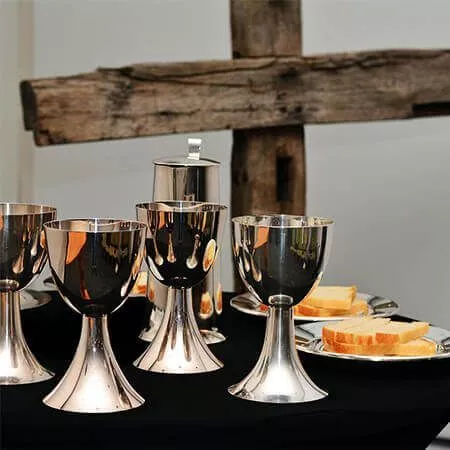The Spiritual Meaning of the LORD’s Supper

Christian believers have celebrated the Lord’s Supper when they meet together since the time Jesus and his disciples ate together in Jerusalem. The Gospels of Matthew (26:17-29), Mark (14:12-25), and Luke (22:7-20) each tell how they meet together to celebrate Passover. During this time, Jesus took bread and a cup of wine, gave thanks, and created a ritual that would become a way of remembering his ultimate act of sacrifice, suffering, and salvation for humanity. It is also called “communion” or “the cup of blessing” (1 Corinthians 10:16), “the Lord’s table” (1 Corinthians 10:21), and “the breaking of bread” ( Acts 2:42 ). In the early Church, it was often called “the eucharist,” or the giving of thanks (Matthew 26:27 & 1 Corinthians 11:23-24).
The Lord’s Supper is an important experience in the Church and in the life of the believer because it contains significant meaning. It has a connection to the ancient celebration of the Passover. Add to that the fact it was instituted on the eve of the crucifixion of Jesus, it becomes a rich memorial to God’s gracious work on behalf of His people. It provides an opportunity to reflect, remember, and recommit ourselves to His work and purpose in our lives. Through the simple symbols of the bread and the cup, we remember our Lord’s death and resurrection, give thanks for His promises, and look forward to His glorious return.
Click image below for our exclusive Lord’s Super Set
In keeping with Passover tradition, Jesus broke the bread before He gave it to the disciples. The breaking of the bread foreshadows the brokenness of His body due to the cruel beating and punishment he was about to endure. Psalm 22 and Isaiah (chapter 53) both allude to the great physical and mental suffering that He would endure. And the wine that he poured out into the cup and drank with his disciples was a fitting symbol of his blood that would be shed the following day. The Jews were to choose a perfect lamb for the Passover meal (Exodus 12:5) and Jesus, “the Lamb of God, who takes away the sin of the world,” as John the Baptist declared (John 1:29), became the means of salvation and redemption for anyone (John 3:16). Like Passover, the Lord’s Supper becomes a time for remembering God’s action on behalf of humanity and becomes a meaningful memorial to be carried out into future generations of believers.
Jesus mentions a new covenant (Luke 22:20). The sacrifice of a lamb was a requirement of the old covenant and his death fulfills its purpose (Hebrews 8:8-13). The one-time sacrifice of Jesus Christ, “the Lamb of God,” establishes a new covenant. This new covenant, in which we receive forgiveness of sins and the promise of eternal life through Christ’s shed blood and broken body, is celebrated as we remember Him in the Lord’s Supper.
The Apostle Paul provides a fitting description and instruction for the Lord’s Supper in 1 Corinthians 11:23-28 —
23 For I received from the Lord what I also delivered to you, that the Lord Jesus on the night when he was betrayed took bread, 24 and when he had given thanks, he broke it, and said, “This is my body, which is (broken) for you. Do this in remembrance of me.” (or “as a memorial of me.”) 25 In the same way also he took the cup, after supper, saying, “This cup is the new covenant in my blood. Do this, as often as you drink it, in remembrance of me.” (or “as a memorial of me.”) 26 For as often as you eat this bread and drink the cup, you proclaim the Lord’s death until he comes.
27 Whoever, therefore, eats the bread or drinks the cup of the Lord in an unworthy manner will be guilty concerning the body and blood of the Lord. 28 Let a person examine himself, then, and so eat of the bread and drink of the cup. (ESV)
The Lord’s Supper is primarily a time set aside for us to remember the person and work of Jesus Christ. The focus for these moments is taken away from our own circumstances or other distractions. Our minds and our hearts are to be directed toward him. With the statements “do this” and “as often” (verse 25), there is an indication that this is a prescription to continue this “until he comes” (verse 26). Participation at the Lord’s Table is not an option and is beneficial for our spiritual well-being. God, through His son, Jesus Christ, calls us to this time and meets us there (Matthew 18:20).
The Lord’s Supper uses tangible elements: bread and the cup. They are given to stir our minds and hearts. The physical sensation of eating and drinking is designed to remind us that Christ’s presence is perceptible. His life, death, and resurrection are real. Just as food and drink are essential to sustain physical existence, so also the blessings and benefits that come to us through the body and blood of Jesus Christ are important in the life of the believer.
All Christians generally recognize a special presence of Christ in this ritual, though they differ about exactly how, where, and when Christ is present. In spite of differences among Christians about various aspects of the ceremony, it is acknowledged that it is a sacred moment. It is a time He has called us to set aside from our normal schedule and circumstances to connect to His divine presence. He meets us at the table. In our remembering there is also opportunity for confession. When we take the elements, the bread and the cup, we are reminded that “Christ gave his body and blood for me. He died for me.” We can confess that the symbols of his body and blood was sacrificed for my sins and continue to receive God’s forgiveness in a fresh way.
During the Lord’s Supper we also proclaim “the Lord’s death till he comes” (verse 26). This is not merely a ritual that looks to the past. It is a statement of hope that points to the future. We celebrate God’s work of salvation, we are comforted by His presence in our current circumstances, and we are confident in His promises for the future.
When believers celebrate the Lord’s Supper it is deeply significant and full of meaning. It was first held when Jesus celebrated the Passover feast with His disciples on the evening before He was betrayed. Now, the Lord’s Supper, or Communion, uses the tangible symbols of the bread and the cup to look back at the suffering, death, and resurrection of our Lord, Jesus Christ. It helps us look to our current circumstances with the knowledge that we can face them with God’s presence, forgiveness, and power. We are also reminded to look ahead to His victory over death and His coming again to earth at the end of the age.



Leave a Reply
You must be logged in to post a comment.